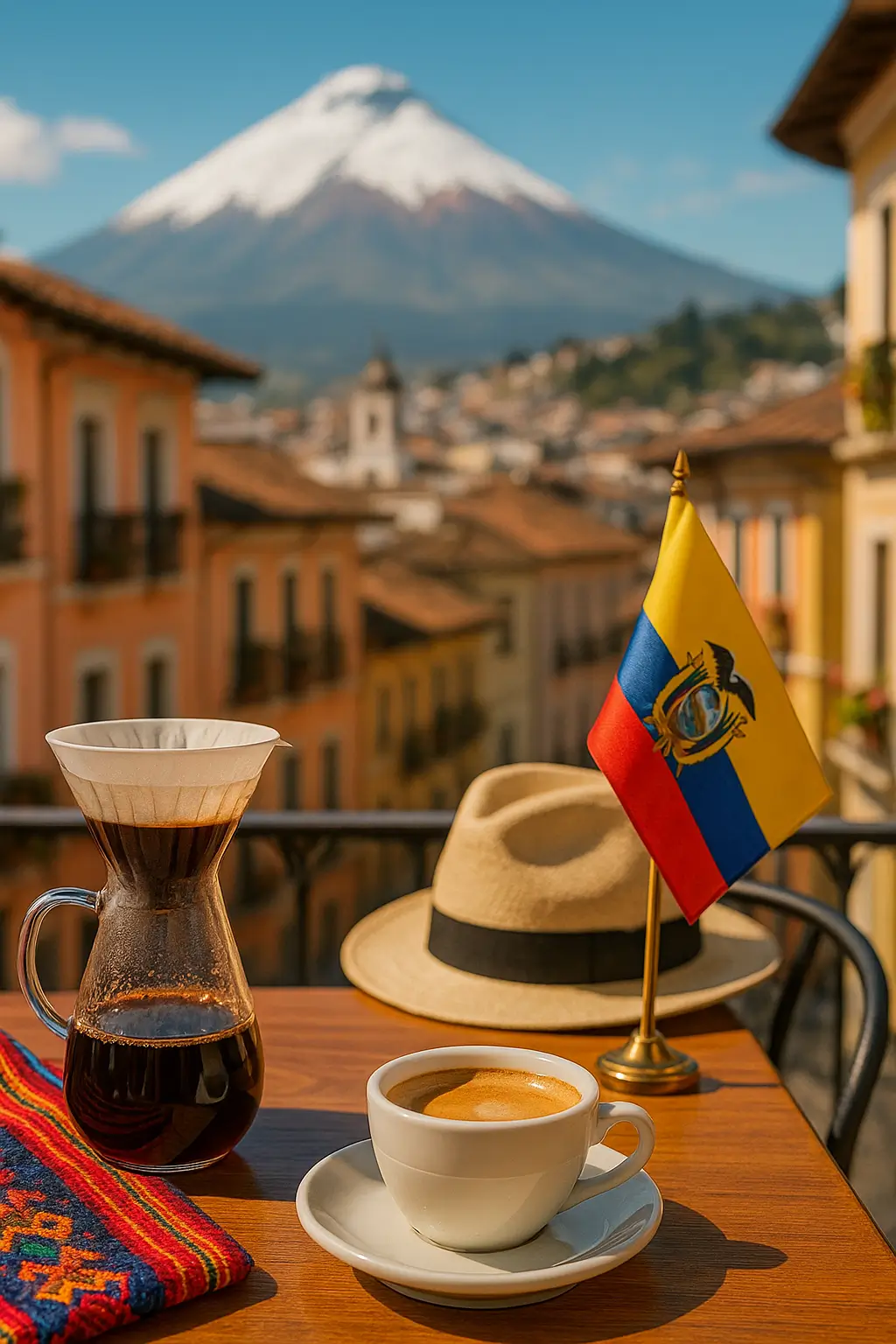Ecuadorian coffee stands out in the global specialty coffee world. Ecuador grows both Arabica and Robusta beans across its many landscapes. This coffee often tastes rich and balanced. You’ll notice pleasant acidity, sweetness, and clear fruit notes. Different altitudes, climates, and processing methods across Ecuador shape these unique flavors. Let’s explore its specific flavors, main growing regions, history, and sustainable practices.
What makes Ecuadorian coffee unique?
Ecuadorian coffee has a rich, balanced flavor that captivates coffee drinkers. This taste comes from the country’s varied geography and careful farming. The flavor often blends bright acidity, high sweetness, and complex fruit notes.
How does Ecuadorian coffee get balanced acidity and sweetness?
Ecuadorian coffee balances acidity and sweetness through ideal growing conditions and careful processing. These elements create a harmonious mix of bright, pleasant acidity with noticeable sweetness. This makes for a well-rounded cup. You might find sweet notes like brown sugar, vanilla, honey, or even allspice in your brew. Some people also taste cooked fruit desserts, which adds to the coffee’s rich profile.
What fruity, floral, and jammy notes does Ecuadorian coffee have?
Ecuadorian coffee often features bright fruit flavors. Look for:
- Zesty citrus notes such as lime and tangerine,
- Luscious berry notes like blackberry and blueberry,
- Delicate floral fragrances,
- A delightful jam-like sweetness,
- Inviting notes of yellow fruits, offering more complexity.
How do regions change Ecuadorian coffee flavor?
Different regions deeply affect Ecuadorian coffee flavor. Diverse landscapes across the country create distinct profiles. For example, coffee from the Intag Valley in northern Ecuador balances acidity, sweetness, and a slight bitterness—sometimes like a tomato. Coffees from southern Loja Province have a unique sweet and sour profile. People want these high-scoring Arabica beans. Also, volcanic regions like Chimborazo Province produce richer aromas and higher acidity. This shows the vast range within Ecuadorian coffee.
Ecuador’s coffee diversity is remarkable. Its varied microclimates and altitudes create many distinct flavors. Each region tells a different story in the cup, from the Andes’ bright notes to the Amazon’s earthy tones.
How does processing affect Ecuadorian coffee flavor?
Processing methods greatly change the final flavor of Ecuadorian coffee. Washed coffees, for instance, produce a clean cup with bright acidity and delicate floral notes. Honey or natural processed coffees, however, offer more body, clear sweetness, and intense fruit notes. Farmers choose a processing method to boost specific qualities in their coffee’s flavor profile.
Key coffee growing regions in Ecuador
Ecuador’s main coffee-growing regions are the Sierra (Andes highlands), the Amazon, and the Coastal areas. These diverse zones contribute to the country’s varied coffee profiles. Each region has unique climates and elevations that shape the coffee beans grown there.
What are the main Sierra (Andes Highlands) coffee regions?
The Sierra (Andes Highlands) is Ecuador’s top region for specialty Arabica. Key provinces here include Loja and Pichincha. Loja Province consistently produces some of Ecuador’s highest-scoring Arabica coffees. These coffees are known for their complex fruit flavors. Pichincha Province, near Quito, also shows promise for high-quality Arabica. It benefits from strong export routes. Elevations in these regions usually range from 1,000 to 2,300 meters. This altitude deeply impacts bean development and flavor complexity.
Where does Ecuador’s Amazon region grow Robusta coffee?
Robusta coffee mainly grows in Ecuador’s Amazon Region. You’ll find it in provinces like Sucumbíos, Orellana, Morona Santiago, and Zamora Chinchipe. These areas have lower altitudes and hotter, more humid climates. These conditions are perfect for Robusta. Farmers choose Robusta here because it naturally resists disease and yields more beans in this environment.
What coastal regions grow Ecuadorian coffee?
Coastal regions like Manabí, El Oro, Los Ríos, and Guayas provinces contribute to Ecuadorian coffee. These areas grow both Arabica and Robusta coffee at lower to mid-altitudes. Manabí Province is Ecuador’s largest producing region, making about 30% of the country’s total coffee. The entire coastal area makes about 50% of Ecuador’s national coffee. This shows its importance to the industry.
Types and varieties of Ecuadorian coffee
Ecuadorian coffee mainly comes in three types: Arabica, Robusta, and the less common Liberica. Arabica is most important for specialty coffee. Robusta plays a key role in volume and coffee blends. Each type and its varieties suit the diverse growing conditions across Ecuador’s landscape.
What Arabica varieties grow in Ecuador?
Ecuadorian coffee growers plant several Arabica varieties. Traditional, well-regarded types include:
- Typica,
- Caturra,
- Bourbon.
Newer varieties like Typica Mejorado, SL-28, Colombia, and Castillo also grow here. Colombia and Castillo are rust-resistant. Farmers brought them from Colombia. They thrive in Sierra regions such as Loja, Pichincha, Carchi, and Imbabura. These varieties add to the complex flavors found in Ecuadorian Arabica coffee.
What are the traits of Ecuadorian Robusta coffee?
Ecuadorian Robusta coffee grows in the Amazon and coastal regions’ lower altitudes. These beans have a strong, often bitter flavor and a thick body. Robusta also has much more caffeine than Arabica. This coffee is common in instant coffee or in espresso blends, where its bold traits are valued.
Does Ecuador grow Liberica coffee?
Yes, Liberica coffee grows in Ecuador, but it is less common than Arabica and Robusta. Liberica offers unique flavors. Its growth fills a smaller, niche spot within the broader Ecuadorian coffee industry.
Growing conditions and processing methods
Ecuador’s unique geography and its farmers’ skill make its coffee beans excellent. The diverse growing conditions and careful processing shape the distinct flavors that are gaining world fame. This focus on quality defines Ecuador’s growing specialty coffee sector.
How do altitude and ecosystems affect Ecuadorian coffee?
Altitude and diverse ecosystems greatly affect Ecuadorian coffee quality. Beans grow at many altitudes, from about 600m in coastal areas to over 2,200m in the high Andes. Higher altitudes slow bean growth. This leads to denser beans with more concentrated, complex flavors. You often taste fruit and floral notes. Ecuador’s varied land creates many microclimates. Farmers use sustainable methods, like natural shade from native trees. They also intercrop with plants such as bananas and inga. This approach boosts coffee quality and helps the environment.
How do climate, volcanic soil, and rain affect Ecuadorian coffee?
Climate, volcanic soils, and steady rainfall are key for Ecuadorian coffee production. Moderate temperatures and reliable rain create ideal conditions for healthy coffee plants and best flavor. The mineral-rich volcanic soils, common in high-altitude regions, give the coffee unique richness and complexity. Water scarcity and climate change affect production, but these challenges push farmers to focus on quality over quantity. This promotes more precise farming methods.
What processing methods does Ecuador use for coffee?
Ecuadorian coffee primarily uses natural, washed, and honey processing. Natural (dry) processing is common, especially on smaller farms. Coffee cherries dry in the sun with the fruit still on. This gives sweeter, fruit-forward flavors. However, growers increasingly use Washed (wet) processing for cleaner cups with bright acidity and floral notes. Honey processing, which leaves some mucilage on the bean while drying, is also getting popular. It creates balanced sweetness and strong fruity notes. This range of methods allows for many different Ecuadorian coffee flavor profiles.
Ecuadorian farmers innovate constantly. They refine their processing methods to unlock even more flavor potential. Their dedication to both tradition and modern techniques truly sets them apart.
How do hand harvesting and quality focus help Ecuadorian coffee?
Hand harvesting and a strong focus on quality help Ecuadorian coffee thrive. Farmers carefully hand-pick only ripe cherries. This ensures uniform, high quality from harvest through processing. Cooperative efforts and direct trade relationships improved farm management and quality control. This was especially true after challenges like the Roya fungus outbreak. This shared dedication to careful selection and processing raises the overall standard of Ecuadorian coffee.
The history and future of Ecuadorian coffee
Ecuadorian coffee production started in the 1860s, mostly in Manabí Province. This sector has seen times of big growth and decline. Now, it is revitalized. The coffee industry is important to the country’s economy. It supports thousands of producers and adds to export money.
When did Ecuadorian coffee production start?
Commercial production of Ecuadorian coffee began in the 1860s. It started in Manabí Province. From these early days, the industry expanded across the country. By the early 1900s, Ecuador became a known coffee exporter globally. This marked a time of strong growth and influence.
What challenges did Ecuadorian coffee face, and how did it recover?
Ecuadorian coffee faced many challenges. Prices dropped in the 1980s, hurting many South American producers. But strong recovery efforts began in the 2000s. These efforts focused on quality and sustainable practices. During this time, Ecuador became one of the few countries successfully growing both Arabica and Robusta. This showed its commitment to recovery and growth.
What is the current sustainability and economic impact of Ecuadorian coffee?
Ecuadorian coffee has a major impact on sustainability and the economy. It supports about 75,000 producers across the country. Challenges remain, like older coffee trees, small farms, and labor shortages. But the industry is innovating. Better farming methods, new disease-resistant varieties, and widespread sustainable practices move the sector forward. Coffee tourism also boosts local economies and raises global awareness of Ecuadorian coffee.
Why choose Ecuadorian specialty coffee?
Choosing Ecuadorian specialty coffee gives consumers and roasters strong reasons to pick these unique, ethical beans. This rising origin offers deep flavor, supports sustainable practices, and directly helps small producers. Its distinct qualities make it a top choice in the global coffee market.
What unique terroir and flavors does Ecuadorian coffee offer?
Ecuadorian coffee has unique terroir and deep flavor complexity. This comes from its distinct geographical features and diverse microclimates. The varied altitudes, from coastal plains to Andean peaks, create a range of growing conditions. These conditions influence how beans develop. You get a wide array of flavors. This makes each cup unique and memorable. Environmental factors and careful farming produce a complexity rare in other coffee origins.
How does Ecuador commit to sustainable and organic coffee?
Ecuador strongly commits to sustainable and organic coffee farming. Many farms, especially small family-owned ones, use organic methods. This reduces environmental impact. This dedication to sustainable practices matches what consumers want: ethical and eco-friendly products. These efforts help both the planet and the coffee’s nuanced flavors.
How does choosing Ecuadorian coffee help small producers and the local economy?
Choosing Ecuadorian coffee directly helps the many small family farms that power the industry. These producers often rely on direct trade relationships. This ensures they get fair prices for their high-quality beans. This support helps the local economy, lets communities thrive, and keeps traditional farming alive. By buying Ecuadorian coffee, you directly help these vital farming communities.
Ecuadorian coffee at a glance
| Region | Provinces | Altitude | Key Crop / Notes |
|---|---|---|---|
| Sierra (Andes Highlands) | Loja, Pichincha, Carchi, Imbabura | 1,000–2,300 meters | Specialty Arabica, complex fruity flavors |
| Amazon | Sucumbíos, Orellana, Morona Santiago, Zamora Chinchipe | Lower altitudes | Robusta, disease resistance, higher yield |
| Coastal | Manabí, El Oro, Los Ríos, Guayas | Lower to mid-altitudes | Arabica and Robusta, Manabí (30% total output), Coastal (50% national output) |
Ecuadorian coffee truly is a hidden gem in the specialty coffee world. It offers excellent quality and incredibly diverse flavors. Its unique traits show the country’s varied ecosystems, dedicated producers, and evolving processing methods. Plus, a strong commitment to sustainable practices forms the industry’s ethical core. Seek out Ecuadorian coffee from your local specialty roaster or café. Taste its vibrant flavors yourself!









